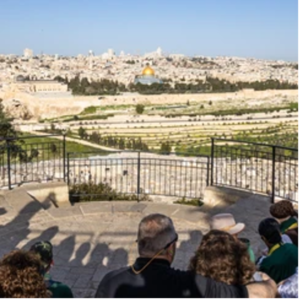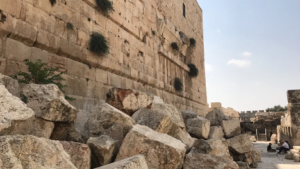As Becky and Charles exited the bus at the top of the hill overlooking Jerusalem, they could hardly believe their eyes. They had finally arrived, and tears began to gently flow down their faces as they looked out over the city where Jesus was crucified. Its valleys were steeper than they had imagined, and the splendor of the historic walls was greater than expected. But the thing that touched them the most was remembering those mournful words spoken by Jesus as He entered the city the Sunday before His death, “O Jerusalem, Jerusalem… how often would I have gathered your children together as a hen gathers her brood under her wings.” Jesus loved Jerusalem, and above all, He loved the people who walked its streets and worshipped in its buildings—remnants that are still visible today and which serve as irrefutable evidence of the reliability of the words of Jesus.


Standing atop the famed Mount of Olives and gazing across the Kidron Valley, one of Israel’s most iconic shrines catches the eye of every visitor. Visible for miles, the Golden Dome of the Rock is an Islamic shrine situated on top of one of the Jew’s holiest sites.

Known to Muslims as the Haram Al-Sharif and to Jews as the Temple Mount, this 1.5 million square foot platform is one of the most contested pieces of real estate in the world, but 2,000 years ago, it was home to a glorious and majestic temple built by king Herod the Great; a temple destroyed in the year A.D. 70 but which the Talmud declared that “whoever has not seen Herod’s Temple has not seen a beautiful building in his life” (Bava Basra 4a).
The beautiful Herodian temple has its roots all the way back to the Exodus of 1446 B.C. when God led the Israelites out of bondage in Egypt and into the wilderness to receive His law. As a means of dwelling among them, He instructed Israel to build a tabernacle that could be easily transported from place to place. This moveable shrine became a place of worship and a place for fellowship with God and other Israelites. Constructed with acacia wood overlaid with gold and curtains of goat hair, the tabernacle became a sacred sanctuary where the priests and people of Israel could offer sacrifices, their libations, and receive atonement for their sins (Ex. 25:8, etc.). Described in detail in the book of Exodus, this tent-like structure was designed with a courtyard, a holy place, and a holy of holies.
The tabernacle was essentially basic and small. Its outside perimeter consisted of a curtain-like fence with a dimension of 100 X 50 cubits. A cubit is roughly equivalent to 18 inches in length, and thus, the tabernacle was 150 feet long by 75 feet wide. The interior space contained a courtyard with a bronze altar for sacrifices and a laver for ritual cleansing. The latter 2/3 of the courtyard contained the tent of meeting (Exodus 38:8). Inside the tent was the holy place which had a table for bread, a golden lampstand, and an altar of incense. The Holy place also contained a beautifully crafted curtain hanging on four golden pillars, which separated it from the perfectly shaped cube of the Holy of Holies, where the sacred ark of the covenant was housed. This was also the place where Yahweh manifested his presence above the cherubim sitting on top of the ark of the covenant. In the 10th century B.C., the ark, and later the Tabernacle, were moved to Jerusalem, where eventually it found a permanent home in what came to be known as Solomon’s temple.

The First Temple
In the 10th century B.C., the Tabernacle eventually came to reside on a hill north of Jerusalem, where Solomon erected a permanent home on a threshing floor purchased by King David. Throughout its history, this mountain came to be known by many names (e.g., Mt. Moriah, Mt. Zion, the Haram al-Sharif), but none was more important than the Temple Mount. Bounded on the East by the Kidron and on the West by the Central Valley, the famed structure known as the sacred Temple of the Jews was elaborate and beautiful. Its design and furnishings were described in intricate detail in the books of Chronicles and Kings. Today, it is known as the FIRST Temple, and some argue that portions of it can still be seen in the walls along the eastern slope.
In 586 B.C., the Babylonians destroyed this sacred temple along with much of Jerusalem. Evidence of that destruction can still be seen on the eastern slopes of the city of David, where Israeli Archaeologists Yigal Shiloh discovered arrowheads and layers of ash within the remains of residential quarters and government buildings (Shanks 36). The conquered and beleaguered Jews were then carried away as slaves but eventually returned some 70 years later to once again build their house of worship. This began the next phase of its storied history, known today as the 2nd Temple period.
The Second Temple
According to the books of Ezra and Haggai (Ezra 3:12; Haggai 2:1-3), this second temple paled in its beauty and grandeur compared to the temple of Solomon. Centuries later (23 B.C.), all of that began to change when King Herod the Great began to renovate and expand the temple in Jerusalem, making it one of the great wonders of the world and one that even mesmerized the disciples of Jesus, who had remarked: “what wonderful buildings and stones” (Mark 13:1). But, Herod’s wonderful buildings of the temple did not stand for long.
In A.D. 70, the grand temple of the Jews was destroyed yet again. On this occasion, the Roman General Titus laid siege to the city and robbed the temple of its lavish furnishings. The looting and victory march back to Rome and up to Capitoline Hill were memorialized in the well-known Arch of Titus. Carved on one of its interior walls is a depiction of Roman figures carrying the menorah and table of shewbread in a triumphal procession. But, the Roman soldiers and slaves had not only stripped the temple of its sacred items, but they also dismantled it as well and pushed many of the stones over the sides of its foundational walls to the streets below.
Fulfilled Prophecy
In a fascinating foretelling of the future, Jesus of Nazareth had actually predicted this destruction and declared that not one stone would be left standing upon another (Matt. 24:2). That prophesy was fulfilled, and as a result of the Roman siege and destruction that followed, the buildings on the temple mount were completely dismantled. When archaeologists excavated the base of the temple mount, hundreds of Herodian building stones that had been shoved off the platform from above were found, some becoming permanently embedded in the street below. In the rubble of this mammoth-sized destruction, numerous discoveries have been made, including this beautifully carved cornice containing a Hebrew inscription that reads “the place of trumpeting.” The piece had likely come from somewhere near a tower or platform at the southwestern corner of the Royal Stoa.
The Royal Stoa and those beautifully adorned buildings of the temple no longer exist. The stately colonnaded porches have disappeared, and the temple buildings that had once captivated the disciples of Jesus are completely in ruin. The prophecy of Jesus had come true. The 2nd Temple was destroyed, and on the temple platform, not one stone was left standing upon another. Today, the Islamic Dome of the Rock, constructed in 685 A.D, has taken the place of the temple’s inner sanctuary, and the Al Aqsa Mosque sits where the Royal Stoa had proudly bejeweled the Jerusalem skyline. What Jesus had prophesied had come true. While the retaining walls undergirding the temple itself remain, the stones on the temple mount itself were completely dismantled. The Bible is right again.
_____________________________________________
Works Cited
Shanks, Hershel. “The City of David After Five Years of Digging,” Biblical Archaeology Review 11.6 (1985): 22–27, 30–33, 36–38.


